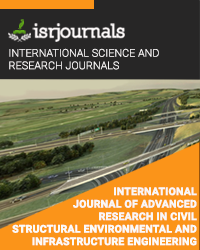production of bioethanol from sweet sorghum
S.Jeevanandhan,D.Ganesh
Published in International Journal of Advanced Research in Civil,Structural,Environmental and Infrastructure Engineering and Developing
ISSN: 2320-723X Impact Factor:1.7 Volume:3 Issue:1 Year: 05 April,2017 Pages:482-487

Abstract
The consumption of bioethanol as biofule may reduce greenhouse gases, gasoline imports. Also it can be replaced with lead or MTBE (Methyl tert-butyl ether) that are air and underground water pollutants, respectively. Plants are the best choice for meeting the projected bioethanol demands. For this scope, a comparative analysis of the technological options using different feedstocks should be performed. Our research and other studies indicate that sweet sorghum can be used as a feedstock for ethanol production under hot and dry climatic conditions. Because, it has higher tolerance to salt and drought comparing to sugarcane and corn that are currently used for biofuel production in the world. In addition, high carbohydrates content of sweet sorghum stalk are similar to sugarcane but its water and fertilizer requirements are much lower than sugarcane. Also, sugarcane is not a salt tolerant plant. On the other hand, high fermentable sugar content in sweet sorghum stalk makes it to be more suitable for fermentation to ethanol. Therefore, it is suggested to plant sweet sorghum for biofule production in hot and dry countries to solve problems such as increasing the octane of gasoline and to reduce greenhouse gases and gasoline imports.
Kewords
Sweet sorghum, Carbohydrate, Bioethanol, Biofuel.
Reference
1. L. Chum, and R.“Overend. Biomass and renewable fuels”, Fuel Bioprocessing Technology, vol.17, Jun. 2001, pp. 187-195, doi:10.1016/S0378-3820(01)00146-1. 2. G. Najafpour, H. Younesi, and K. Ismail. “Ethanol fermentation in an immobilized cell reactor using S. cerevisiae”, Bioresouce Technology, vol.92, May 2004; pp.251-260, doi:10. 1016/j.biortech.2003.09.009. 3. K. Wu, C. Chang, and J. Chang. “Simultaneous production of biohydrogen and bioethanol with fluidize-bed and packed-bed bioreactors containing immobilized anaerobic sludge”, Process Biochemistry, vol.42, Jul. 2007, pp.1165-1171, doi:10.1016/j.procbi o.2007.05.012. 4. F. Bai, W. Anderson, and M. Moo-Young, “Ethanol fermentation technologies from sugar and starch feedstocks”. Biotechnology Advances, vol. 26, Jan. 2008, pp. 89-105, doi:10.1016/j.biotechad v.09.002. 5. E. Billa, D. Koullas, and B. Monties, “Structure and composition of sweet sorghum stalk components”, Industrial Crops Product, vol.6 Aug. 1997, pp.297-302, doi: 10.1016/S0926-6690(97)00031-9. 6. W. Bryan, “Solid state fermentation of sugars in sweet sorghum”, Enzyme Mircrobiology Technology, vol.12, Jan. 1990, pp.437-442, doi: 10.1002/bit.260270106. 7. J, Bvochnra, J. Read, and R. Zvauya, “Application of very high gravity technology to the cofermentation of sweet stem sorghum juice and sorghum”, Industrial Crops Product, vol. 11, Jan. 2000, pp.11-7, doi:10.1016/S0926-6690(99)00029-1. 8. R. Liu, J. Li, and F. Shen, “Refining bioethanol from stalk juice of sweet sorghum by immobilized yeast fermentation”, Renewable Energy, vol.33, May 2008, pp.1130-1135, doi:10.1016/j.renene. 200 7.05.046. 9. G. GosseOverview on the different routes for industrial utilization of sweet sorghum”, First European seminar on sorghum for energy and industry, ToulouseFrance (1996), pp. 1-3 10. E. Gnansounou, A. Dauriat, and C. Wyman, “Refining sweet sorghum to ethanol and sugar: economic trade-offs in the context of North China”, Bioresource Techonlogy, vol. 96, Jun. 2005, pp985-1002, doi:10.1016/j.biortech.2004.09.015. 11. M. Cazetta, M. Celligoi, J. Buzato, and I. Scarmino, “Fermentation of molasses by Zymomonas mobilis: Effects of temperature and sugar concentration on ethanol production”, Bioresouce Technology, vol.98, Nov. 2007, pp.2824-2828, doi:10.1016/j.biortech.2006.08.026. 12. Y. Isono, G. Araya, and A. Hoshino, “Immobilization of s. cerevisiae for ethanol fermentation on γ-Alumina particles using a spray-dryer”, Process Biochemistry, vol. 8, Aug. 1995, pp.743-746, doi:10.1016/0032-9592(94)00052-2. 13. J. Tzeng, L. Fan, and Y. Gan, “Ethanol fermentation using immobilized cells in a multistage fluidized bed bioreactor”, Biotechnology & Bioengineering, vol.10, Dec. 1991, pp.1253-1258, doi: 10.1002/bit.260381019. 14. B. Prasad, and I. Ishra, “On the kinetic and effectiveness of immobilized whole-cell batch cultures”, Bioresource Technology vol.53, Mar. 1995, pp. 275-269, doi:10.1016/0960-8524(95)00096-W. 15. R. Liu, J. Li, F. Shen, and Q. Sun, “Bioethanol fermentation from stalk juice of sweet sorghum by immobilized yeast”, Journal of Shanghai Jiaotong University, vol.S.1, Dec. 2005, pp.146-151, doi: cnki:sun:tran.0.2005-S1-027.

